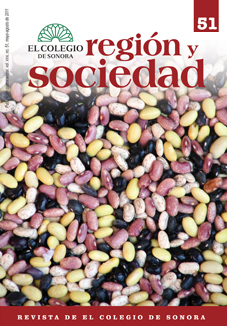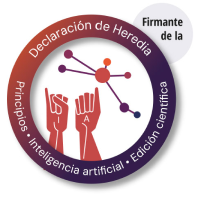 |
 |
 |
 |
 |
 |
 |
 |
 |
 |
 |
 |
Abstract
This article intends to analyze the behavior of sustainable development in Mexico's regions during the period between 2000-2005, considering that sustainable development articulates growth, social justice and ecological conservation. The analysis concludes that sustainable regional development in this country is deteriorating, with inequalities and increasing imbalances between economy, welfare and environment. In order to quantify this deterioration, the index of sustainable water development was used as an indicator.
References
Appendini, Kirsten, Daniel Murayama y Rosa Ma. Domínguez. 1972. Desarrollo desigual en México, 1900 y 1960. Demografía y Economía VI (1): 1-39.
Azar, Christian, John Holmberg y Kristian Lindgren. 1996. Socio-ecological Indicators for Sustainability. Ecological Economics 18: 89-112.
Bakkes J.A., GJ. Van den Born, J.C. Helder, RJ. Swart, Hope C. W, y J.D.E. Parker. 1994. An Overview of Enviromental Indicators: State of the Art and Perspectives, PNUMA/RIVM, Nairobi: United Nations Environment Programme.
Boisier, Sergio. 1996. Modernidad y territorio. Santiago de Chile: ILPES.
CEPAL. 1998. Recomendaciones de las reuniones internacionales sobre el agua: de Mar del Plata a París; http://www.eclac.org/cgi-bin/getProd.asp?xml=/publicaciones/xml/0/4480/P4480.xml&xsl=/drni/tpl/p9f.xsl&base=/drni/tpl/top-bottom.xsl (enero de 2008).
CIFOR. 1999. The Criteria & Indicators Toolbox Series. Jakarta: CIFOR.
CMIC. 2005. La construcción. Industria sustentable. México.
CMMAD. 1988. Nuestro futuro común. Madrid: Alianza Editorial.
David, Ricardo. 1987. Principios de Economía Política y de Tributación (1817). México: Fondo de Cultura Económica.
Delgadillo M., Javier, Felipe Torres T, y José Gasea Z. 2001. Distorsiones del desarrollo regional de México en la perspectiva de la globalización. Momento Económico 115: 30-44.
FAO. 1994. FESLM: an International Framework for Evaluating Sustainable Land Management. Roma: World Soil Resources Report.
Ferranti, D., G. Perry, F. Ferreira y M.Walton. 2003. Desigualdad en América Latina y el Caribe: ¿ruptura con la historia? Resumen ejecutivo. Banco Mundial.
Garza, Gustavo. 2004. Estudios regionales en México. Selección de teoría y evidencia empírica: desarrollo regional, reseña. Estudios Demográficos y Urbanos 19 (2): 465-472.
––––––––––.1997. Tendencias de las desigualdades urbanas y regionales en México 1970-1996. Estudios Demográficos y Urbanos 3 (15): 489-532.
Hammond, A., A. Adriaanse, E. Rodenburg, D. Bryant y R. Woodward. 1995. Environmental Indicators: A Systematic Approach to Measuring and Reporting on Environmental Policy Performance in the Context of Sustainable Development. Washington, D. C: World Resources Institute.
Harrington L.W, P. Jones y M. Winograd. 1994. Operationalizing Sustainability: A Total Productivity Approach. Land Quality Indicators Conference, CIAT, Cali, 1-34.
Hernández Laos, Enrique. 1984. La desigualdad regional en México. En La desigualdad en México, coordinado por Rolando Cordera Campos y CarlosTello, 155-192. México: Siglo XXI.
Howard, G., y J. Bartram. 2003. Domestic Water Quantity, Service Level and Health. Geneva: World Health Organization.
ILPES. 1980. Ensayos sobre planificación regional del desarrollo. México: Editorial Siglo XXI.
INEGI. 1995 y 2005. Conteos de población y vivienda. Aguascalientes: INEGI.
––––––––––.1930-2000.Censos de población y vivienda. Aguascalientes: INEGI.
IUCN. 1997. Un enfoque para la evaluación del progreso hacia la sustentabilidad. Serie Herramientas y Capacitación. Cambridge: IUCN/International Development Research Center.
Kuznets, S. 1955. Economic growth and income distribution, The American Economic Review 45 (1): 3-28.
Lydall, H. R 1979. A Theory of Income Distribution. Oxford: Clarendon Press.
Mass, M. 2003. Principios generales sobre manejo de ecosistemas. En Conservación de ecosistemas templados de montaña en México, editado por O. Sánchez, E. Vega y O. Monroy. www.ine.gob.mx/ueajei/publicaciones/ConsultaPublicación.htm?id_pub0395&id_tema=3&dir=Consultas/.
Mathus, Marco A. 2009. Crecimiento económico y distribución del ingreso en el estado de Oaxaca: 1990-2000.Tesis doctoral, Instituto Tecnológico de Oaxaca.
Miguel, Andrés E., Pedro Maldonado Cruz y Julio César Torres Valdez. 2008. La entropía como indicador de las desigualdades regionales en México. Economía, Sociedad y Territorio VIII (27): 693-719.
Muller, S. 1995. Evaluating the Sustainability of Agriculture at Different Hierarchical Levels: A Framework for the Definition of Indicators. Ponencia presentada en Scientific Workshop on Indicators of Sustainable Development, Wuppertal, Alemania.
Ningu, Julius Kenneth, Jorge Torres Jácome, Sonia Emilia Silva Gomez y Ricardo Pérez Aviles. 2006. Análisis de los impactos del Tratado de Libre Comercio de América del Norte en México desde la óptica de desarrollo sustentable (1994-2004). Rumbo Rural II(5).
PNUD. 2005. Informe sobre desarrollo humano, México 2004. México: PNUD.
Porter, Michael E. 1991. La ventaja competitiva de las naciones. Barcelona: Esplugues de Llobregat.
Ramírez, María Delfina. 1986. Las desigualdades interregionales en México de 1970a 1980. Estudios Demográficos y Urbanos 1 (33): 351-373.
Ruiz Chiapetto, Crescencio. 1997. Desigualdades regionales en México, 1900 a 1993. Estudios Demográficos y Urbanos 11 (3): 533-582.
Sainz Santamaría, Jaime y Mariana Becerra Pérez. 2008. Los conflictos por agua en México, Instituto Nacional de Ecología, http://www.ine.gob.mx/dgipea/descargas/conf_agua_mex.pdf (octubre de 2008).
Santaella, Olivia. 2008. La sustentabilidad de la producción de mezcal de Tóbala en el distrito Solo de Vega. Tesis de maestría, Instituto Tecnológico de Oaxaca.
SEMARNAT-CONAGUA. 2006. Situación del subsector agua potable, alcantarillado y saneamiento (varios años). México: SEMARNAT-CONAGUA.
Shaw, D., y S. Kidd. 1996. Planning Sustainable Development: Principles and Implementation. Journal of Planning Education and Research 15 (3): 237-241.
Syers, J. K., A. Hamblin y E. Pushparajah. 1994. Development of Indicators and Thresholds for the Evaluation of Sustainable Land Management. En 15th World Congress of Soil Science, 398-409. México: INEGI/Comisión Nacional del Agua.
Taylor, D.C., M.Z. Abidin, S.M. Nasir, M.M. Gashali y E.F.C. Chiew. 1993. Creating a Farmer Sustainability Index: A Malaysian Case Estudie. American Journal of Alternative Agriculture 8: 175-184.
Unikel, Luis. 1976. El desarrollo urbano de México. Diagnóstico e implicaciones futuras. México: El Colegio de México.
Winograd, M. 1995. Indicadores ambientales para Latinoamérica y el Caribe: hacia la sustentabilidad en el uso de tierras. Buenos Aires: Grupo de Análisis de Sistemas Ecológicos.
Open access policy
The authors who publish in región y sociedad accept the following conditions:
In accordance with the copyright laws, región y sociedad recognizes and respects the authors’ moral rights, as well as the ownership of property rights, which will be transferred to the journal to disseminate the articles in open access. región y sociedad does not charge the authors for submitting and processing articles for publication.
All the texts published by región y sociedad —with no exception— are distributed under a Creative Commons license 4.0 Attribution – Noncommercial (CC BY-NC 4.0 International), which allows third parties to use the publication as long as they mention the works’ authorship and the first publication in this journal.
The authors can enter into independent and additional contractual agreements for the nonexclusive distribution of the version of the article published in región y sociedad (for instance include it into an institutional repository or publish it in a book) as long as they clearly indicate that the work was published for the first time in región y sociedad.
For all the above, the author(s) must send the Letter of transfer of property rights of the first publication duly filled in and signed by the author(s). This letter can be sent by e-mail as a PDF to: region@colson.edu.mx






